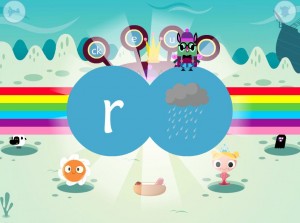I have to recognize that phonetics has always been the least appealing aspect of learning/teaching the English language for me. Being a Spanish speaker, it is quite scary when the very first thing you are told to learn by heart is the IPA chart, specially if your teacher’s accent had nothing to do with the RP you were supossed to be learning.
Fortunatelly, things have changed since I started learning English two decades ago, and after doing some research about Synthetic Phonics, I came across a website that caught my attention. It is called ‘Teach Your Monster to Read‘, and it is intended for native speakers of English aged 4 and above. In this case, and even though there could be some pupils who were not able to understand all that is being said during the game, it is quite intuitive, so I consider that it could be used with Spanish speakers from the First and Second Cycle of Primary.
The first thing that pupils will find about this game is that they have to design their own avatar, whose physical features are highly personalisable, with the possibility of adding new complements along the game. This could help children feel motivated and forget that they ‘have to learn’, and just learn while having a good time. Moreover, each stage adds a new type of game, so the children can choose among a variety of mini-games that makes it more interesting as the level goals are achieved.
Whenever a new sound is introduced, the game provides a word beginning with that sound, but instead of doing it in the written form, which could be difficult for early readers, it is done using an easily-recognisable picture like the one below (‘r’- like in ‘rain’).
In my opinion, it is a simple but effective way of learning English phonics. Based on Synthetic Phonics, phonemes are presented following the frequency rate that is typical of these methods, but there is no feeling of repetitiveness, and when more than one phoneme is presented at a time, they form a real word, there are not just random groupings of letters.
Another positive aspect about this proposal is that, whereas there is a version that can be downloaded at a price for tablets, it is free of charge for PC and laptops. Not having to spend extra money so the pupils can use it using the computer lab or at home, is great.



Hi Loli! I would like to start by saying that I totally agree with you: phonetics is not the most attractive aspect of the English language for any of us, either for children. Due to it, the title of your entry piques my curiosity, and I decided to go through the whole of it. The website you were talking about and its features seemed awesome! It was too good to be true, so I decided to see it with my own eyes. I even opened my own account. The truth is that you were completely right! The fact that the game is based on little challenges that are linked by a story, makes children, as you said, learn while they are motivated and having fun. That in my opinion is something essential for achieving a meaningful learning. Of course, being so visual and intuitive gives it extra points. Finally apart from that, I consider that it also has some features which make it really useful. For example:
– It provides pupils the opportunity of carrying out their own self-assessment (if they do not complete successfully the challenge, they won’t be able to do the next one)
– And another one that came to my mind while I was reading your entry, and I discovered you ended up with; nowadays although some families do not have lots of facilities, most of them have a computer at home, so it is an excellent tool to continue practicing this topic at home.
Hello Azu, and thanks for reading and commenting my post
It seems you understood perfectly the reason why I just loved the webpage. In fact, the pictures I included are taken from my session, and although it could seem too easy for adults, the time spent was worth the benefit.
I will read you soon again.
Loli, excellent post. Suggesting new materials and resources is always good, and why not? It may be interesting to put this tool into practice during your Practicum and check its effectivity in real contexts. Azu did well in exploring this further and contributing with even more information.
Hi Raquel, it’s good to know that you liked the post. I’m always trying to find new resources that could help pupils improve their English, and if it can be done while having fun, what else could I ask for?
I will surely give it a try with students as soon as I can.